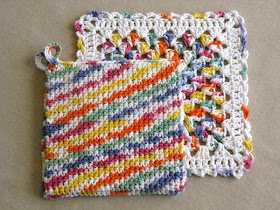I picked up this free pattern in a favorite craft store. The pattern was called “Grandma Leona’s Hot Pad” and the sample was fabulous. It was nice and thick. It looked simple. However, the directions were really poor. It was as if Grandma Leona dictated them from memory, over the phone, when she was half asleep! Because that sample looked so good, I tried to figure out the directions and gave up a number of times. But I persisted long enough to finally figure out what Grandma Leona meant, and this hot pad really is as great as something from a grandma ought to be.
Here are better directions, I hope! I think you’ll probably see why it was hard to figure out. It doesn’t sound easy, but the pictures ought to help.
Materials: 2 balls, worsted weight, cotton yarn. (each ball makes 1 hot pad) Size G crochet hook.
Gauge: 4 sc = 1"; 6 rows = 1" (When I use a G hook with 26 chain foundation, the hot pad usually measures about 6 3/4 inches. If you like your hot pads bigger, use 28 or 30 chains in the foundation. Then you would be counting 27 or 29 sc stitches in each row)
Foundation: Chain 26.
Row 1: Sc in the second chain from the hook, then sc in each chain across. (25 sc) Chain 1 and turn.
Row 2: Pick up the back loop of the first sc and the bottom loop of the foundation chain opposite, at the same time. Yarn over and pull through the two stitches on the hook, then another yarn over and pull through the two loops remaining on the hook. This makes the first sc of row 1.
Continue to work in both the back loops of the previous row and in the bottom loops on the opposite side. Sc in each st across. (25 sc.)
The last stitch is critical. In the picture, you can see the turning chain from row 1 at the very end of the row. Count to make sure you have 25 sc.
Again, chain 1 and turn.
Again, chain 1 and turn.
Row 3 and continue: Working in the back lps of the stitches in the last row and in the front lps of the stitches of the row before the last row, at the same time, continue to sc in each st across, chain 1 and turn. Continue working the rows in this way until the hot pad measures square.
As you add rows, you will see that the bottom is rounded and that you are making the hot pad double. Each row lays halfway across the previous row. This makes the hot pad nice and thick. Once you get the hang of picking up both stitches, it is as simple and relaxing as most single crochet is.
As I mentioned, you need to be careful to pick up the last stitch in each row. It is small and tight and sometimes difficult to see. If you look carefully at the picture, you can see the last two threads that I need to pick up to make the last stitch. Sometimes, I have to pull the turning stitch of the previous row aside to see where to put the last stitch.
The picture above shows the last stitch on the hook. If the hot pad is not squaring up, it could be that you are not catching that last stitch. Count the sc in each row and you should be okay.
The picture above shows the last stitch on the hook. If the hot pad is not squaring up, it could be that you are not catching that last stitch. Count the sc in each row and you should be okay.
Measure the hot pad as it progresses. When the hot pad is within one row of being square, work the final row.
Final row: Work in both loops of the sc stitch in the previous row as well as the front loop of the sc stitch opposite on the row before the last one, all at the same time. (3 loops and 1 loop on the hook.) Yarn over and pull through the three stitches, then yarn over and pull through the remaining two loops. This makes the sc. Sc in this manner all the way across and complete the last stitch. Do not make a turning chain. If you don’t want a hanging loop, fasten off the yarn and weave in the tail.
Make a hanging loop: Do not fasten off. Directly from the last stitch, chain 12. Work a sc in the last sc in the last row. Chain 1, then slip stitch in each chain of the hanging loop. End with a slip stitch in the last sc you made. Leave about 6 inches for sewing and cut the yarn. Use a yarn needle to sew the yarn end through the bottom of the hanging loop a couple of times to stabilize it and then weave in the remaining yarn.



















































